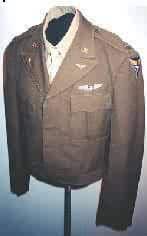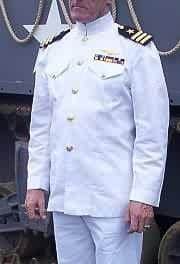Khaki is suggested as a colour since it would allow the same shirts to be worn in both tropical and temperate climates, and the light colour is very effective at reflecting the sun to keep the wearer cool. In most parts of the world the shade also blends in well, making the wearer a harder target for snipers. Naturally the shirt would have name tapes, epaulettes, unit badges etc.
Such a shirt would be worn with "Chino" type trousers of either Khaki, Olive Green or Olive Drab shade. It might also be worn with shorts or BDU trousers.
 Two jackets would be available for wear over the shirt in colder conditions. The "long" jacket would be the existing Class A jacket, which would be worn with or without a belt. The other jacket would be a waist-length "Ike" jacket (right) as I've described elsewhere.
Two jackets would be available for wear over the shirt in colder conditions. The "long" jacket would be the existing Class A jacket, which would be worn with or without a belt. The other jacket would be a waist-length "Ike" jacket (right) as I've described elsewhere.All of the above items would be made of easily laundered cotton.
A tee-shirt and BDU trousers are obviously fatigue wear, but the distinction between Service and fatigue dress now becomes a little blurred. Such a form of service dress as I propose will be very comfortable, so it is likely that it will see wear in a broader range of situations than current dress. It would be useful as walking-out dress and may see wear in urban or field situations when a smarter appearance is wanted and/or there is a low likelihood of combat. Items such as the Shirt and Ike jacket may be combined with BDU trousers or shorts. Such combinations can easily be worn under combat smocks should there be a need for camouflage.
As I've said on another page, a properly designed service dress could be made that Soldiers would feel comfortable wearing and could fill a broad range of roles, making it more economic. It can serve as service dress, parade dress, walking-out dress, messwear, guard wear, barracks wear etc.
For foul weather a long waxed cotton coat such as a "Drizabone" should be issued. This is essentially a greatcoat that is also waterproof. A fleece liner can be added to make this warmer when there is a need. This would be a very welcome thing to have for base sentry duty, and would be parade dress for foul weather conditions.
I'm no great fan of neckties, particularly if worn without a jacket. The Services have a tradition of tucking the end into the shirt in such conditions, although it can be argued this does little for the aesthetics that wearing a tie is supposed to produce.
For very formal occasions a tie may be required. Since such occasions include funerals, it makes sense for the issue tie to be black. A tie clip bearing the unit badge would be a practical and attractive addition.
National Insignia
The standard national insignia for all uniforms other than the Dress uniform should be a subdued version of the American flag in Beige and Red-brown with Silver-grey stars. Such an emblem can be printed on 1" x 2" nylon tape. A red, white and blue embroidered flag would be used on the Dress uniform.
Parade Dress/Formal Dress.
To be worn by officers, honour guards, bandsmen etc.
Personally, I can see no reason why a parade/formal uniform should be uncomfortable. My feeling is that is should be something like the cut and weight of US Navy Dress Whites.
 This uniform would be used for both parades and formal occasions. It would also serve as formal mess wear. It is possible that such a uniform could also be worn as Walking-out dress. Naval Officers seem to use their Dress Whites in this manner.
This uniform would be used for both parades and formal occasions. It would also serve as formal mess wear. It is possible that such a uniform could also be worn as Walking-out dress. Naval Officers seem to use their Dress Whites in this manner.It should be light enough to be comfortable worn over a tee-shirt and the collar of a generous enough cut not to be restrictive.
This new parade uniform would not necessarily be white in colour. There is an opportunity here to promote esprit-de-corps by taking this basic pattern and making it in a wide variety of colour combinations, each unique to a particular unit.
The tunic could be worn with or without a belt, and the trousers may be a matching or contrasting colour. Various insignia and features unique to the unit would be added. Cavalry and Artillery will probably choose yellow or red stripes down the leg. One British cavalry unit has chain-mail epaulettes, and such a feature may appeal to Armor branch.
Headgear would vary. Some units may have an appropriately coloured version of the peaked cap. Other units may such as the special forces and airborne may wear the beret. Cavalry may opt for the Stetson.
Trousers will be dark blue for all uniforms, although for some units there will be an appropriately coloured strip down the seam :- yellow for cavalry, red for artillery, white for all infantry units etc.
Suggested Tunic colours.
This is a bit of a flight of fancy on my part, but…
Cavalry Dark blue tunic with crossed sabre emblems and brass buttons, Collar same shade of blue. Yellow trouser stripe.
Artillery Dark blue tunic with light blue collar, edged with gold. Red trouser stripe
Air Defence Artillery. Same uniform as Artillery but with a light blue tunic.
Engineering Corps. Black tunic and collar with silver buttons.
Military Police. Dark blue tunic with white piping and shoulder boards. White headgear.
Signals and Electronic Warfare Corps. Blue tunic with yellow collar. Shoulder boards red and white, diagonally divided to represent semaphore flag.
Military Intelligence Light grey with Imperial-Purple collar.
Logistics (Quartermaster, Ordnance, Transportation) Dark cream tunic with chocolate brown collar. Piping and insignia designate different sections. Escort and Patrol Infantry have a white trouser stripe. RSV crews have a yellow stripe.
Army Aviation Olive drab tunic (original colour of USAAF uniforms) with French blue collar. French blue trouser stripe. Headgear –peaked "crush"cap without stiffeners.
Medical. White tunic with surgical green collar. Piping may indicate different sections. Blue piping for dentists, red-brown for veterinary, etc.
Chemical corps. Mustard yellow tunic with blue collar.
Judge Advocate General's Corps Dark blue tunic, pearl grey collar with white piping.
Special Forces. Light green/ Sage green tunic, to represent jungle of Vietnam. Lighter shade of green than the Green of the beret. Delta may have the same tunic but with a black beret.
Combined Armoured Battalions/Regiments. Dark blue tunic with mid blue collar. This uniform to be worn by Tankers, Bradley crews and Armoured Infantry (personnel of these units are rotated through different duties). This unit also worn by the vehicle crews of Carrier Attachment Battalions and armour-orientated Patch forces.
SIF Dark green tunic with black collar.
Infantry.
Traditionally, US infantry have worn Dark blue parade uniforms. Since many other branches already use this colour, I'm going to propose that the Infantry-orientated forces be given distinctive parade uniforms. Putting them in British Army Scarlet is probably out, so I'm going to propose that the base colour for the tunic be a medium green, possibly the Olive Green used for Class As, maybe a bit lighter or yellower.
Airborne units would have a Burgundy collar possibly with maroon piping. MR-type infantry units would have collars of red, blue, white, yellow etc. Soldiers of "The Big Red One" would likely have a red collar (assuming this unit is not a Combined-armoured unit) . It will likely be a matter of considerable debate whether the 101st should have "Airborne" Burgundy or another colour. These green tunics will be worn with dark blue trousers with a white stripe.
Ranger Infantry will wear a dark tan tunic with a Burgandy collar with black trim. The black on the collar represents the old beret colour and the tunic colour will contrast nicely with the beige beret.
(True) Mountain Infantry will wear a Stone-grey tunic with an apple green collar and white piping.






